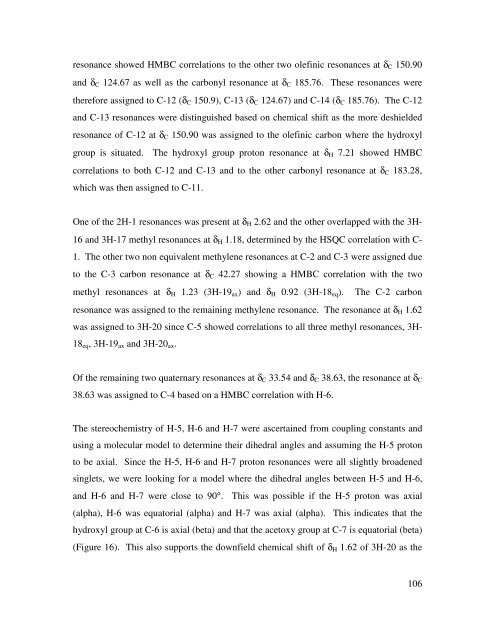university of kwazulu-natal faculty of science and agriculture school ...
university of kwazulu-natal faculty of science and agriculture school ...
university of kwazulu-natal faculty of science and agriculture school ...
Create successful ePaper yourself
Turn your PDF publications into a flip-book with our unique Google optimized e-Paper software.
esonance showed HMBC correlations to the other two olefinic resonances at δC 150.90<br />
<strong>and</strong> δC 124.67 as well as the carbonyl resonance at δC 185.76. These resonances were<br />
therefore assigned to C-12 (δC 150.9), C-13 (δC 124.67) <strong>and</strong> C-14 (δC 185.76). The C-12<br />
<strong>and</strong> C-13 resonances were distinguished based on chemical shift as the more deshielded<br />
resonance <strong>of</strong> C-12 at δC 150.90 was assigned to the olefinic carbon where the hydroxyl<br />
group is situated. The hydroxyl group proton resonance at δH 7.21 showed HMBC<br />
correlations to both C-12 <strong>and</strong> C-13 <strong>and</strong> to the other carbonyl resonance at δC 183.28,<br />
which was then assigned to C-11.<br />
One <strong>of</strong> the 2H-1 resonances was present at δH 2.62 <strong>and</strong> the other overlapped with the 3H-<br />
16 <strong>and</strong> 3H-17 methyl resonances at δH 1.18, determined by the HSQC correlation with C-<br />
1. The other two non equivalent methylene resonances at C-2 <strong>and</strong> C-3 were assigned due<br />
to the C-3 carbon resonance at δC 42.27 showing a HMBC correlation with the two<br />
methyl resonances at δH 1.23 (3H-19ax) <strong>and</strong> δH 0.92 (3H-18eq). The C-2 carbon<br />
resonance was assigned to the remaining methylene resonance. The resonance at δH 1.62<br />
was assigned to 3H-20 since C-5 showed correlations to all three methyl resonances, 3H-<br />
18eq, 3H-19ax <strong>and</strong> 3H-20ax.<br />
Of the remaining two quaternary resonances at δC 33.54 <strong>and</strong> δC 38.63, the resonance at δC<br />
38.63 was assigned to C-4 based on a HMBC correlation with H-6.<br />
The stereochemistry <strong>of</strong> H-5, H-6 <strong>and</strong> H-7 were ascertained from coupling constants <strong>and</strong><br />
using a molecular model to determine their dihedral angles <strong>and</strong> assuming the H-5 proton<br />
to be axial. Since the H-5, H-6 <strong>and</strong> H-7 proton resonances were all slightly broadened<br />
singlets, we were looking for a model where the dihedral angles between H-5 <strong>and</strong> H-6,<br />
<strong>and</strong> H-6 <strong>and</strong> H-7 were close to 90°. This was possible if the H-5 proton was axial<br />
(alpha), H-6 was equatorial (alpha) <strong>and</strong> H-7 was axial (alpha). This indicates that the<br />
hydroxyl group at C-6 is axial (beta) <strong>and</strong> that the acetoxy group at C-7 is equatorial (beta)<br />
(Figure 16). This also supports the downfield chemical shift <strong>of</strong> δH 1.62 <strong>of</strong> 3H-20 as the<br />
106

















